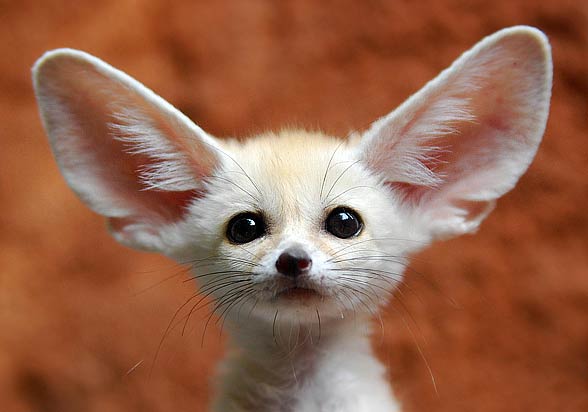Fennec fox / fennec (Vulpes zerda)
Fennec is a small nocturnal fox. It also is the smallest species of canid. Thanks to its great charm and small size, fennec often becomes a pet animal, which everyone admires. But how does its life look like in freedom? Does unquestionable beauty help it in its struggle for survival or is it a curse for it?
Classification
- Kingdom: Animalia
- Phylum: Chordata
- Class: Mammalia
- Order: Carnivora
- Family: Canidae
- Genus: Vulpes
- Species: Vulpes zerda

Occurrence
It lives in the area of North Africa and Asia. You can find it from Morocco to Egypt, Niger, Kuwait and the Sinai Peninsula.
The lairs are under the sand, in open desert areas or in places overgrown with dry grasses. The total area of the fennec burrow, excavated in dense soil, reaches 120 m2 (1,292 sq ft) and has a maximum of 15 entrances. Family groups build nests in close proximity or combine them into one. In the case of a soft, loose substrate (sand), the burrow has a simpler construction and only one entrance leads to it.

Characteristic
Fennec is the smallest representative of canids in the world. Fluffy fur, cream-colored – reflects the sun’s rays during the day to avoid overheating, while at night it keeps the temperature constant.
Why do fennec foxes have big ears?
The most characteristic external feature is the huge ears – the largest in relation to the body size of all canines. They fulfill a very important function – they dissipate heat. Because there are a lot of subcutaneous blood vessels on their surface, the fennec’s hearing is sensitive enough to be able to hear the prey beneath the ground. Fennecs’ distinctive ears radiate body heat and help keep these animals cool.
Paws are protected by fur to prevent burns caused by contact with hot sand. Eyes: large, almond-shaped, dark, set on the front of the mouth; small, light brown or red-colored nose. A fluffy tail, darker at the end.

Diet and hunting
Despite its inconspicuous size and charming muzzle, it is a skilled hunter, active at night, eating mostly insects, birds, eggs and rabbits.
It hunts by making high and long jumps, thanks to which it is easy to catch a quickly escaping victim. An individual can jump up to 61 cm (2 ft) high and 120 cm (4 ft) forward. It also helps it to escape predators.
In the course of hunting, the fennec ears work hard, often changing their position to target the prey. Often the ears are directed downwards so that the predator can easily trace animals that are underground.
The fennec organism has been well adapted to the water deficit – kidneys are constructed in such a way as to limit the losses in water management. It also needs enough liquid from the victims’ bodies if there is drought during a given period.

Social behavior
The most important members of the group are the alpha couple and their offspring. The young from the previous year stay with their parents even when another litter was born. Like most canines, it emits sounds specific to its family: it barks, and when it feels endangered, it growls. Noises reminiscent of the purring of a domestic cat were also recorded.
Each member of the flock is involved in the life of the group and is in constant contact with all the “brothers”. Males show more aggression and territoriality by marking the terrain during the period of estrus. Its family life was not well known, and conclusions are usually drawn from its captive behavior.

Natural enemies
The biggest threats are the African species of the eagle owl, caracal, jackal, striped hyena (Hyaena hyaena), and the Saluki, a greyhound-like domestic dog inhabiting the area where fennec occurs. It is believed, however, that this animal is very difficult to capture, and reports on the hunting successes of other predators outside the eagle owl are treated with a distance, even in disbelief.

Reproduction
The dominant couple creates a lifetime relationship. Only it can reproduce, so it controls the size of the herd. The reproductive period takes place between January and February, and females give birth from March to April. In captivity, litters come into the world later – from March to July. Although reproduction can last for a whole year, females only give birth once. After copulation, the male becomes very aggressive while protecting the female. In addition, it provides food during pregnancy and feeding.
Gestation usually lasts 50 – 52 days, but sometimes about 63 days (in captivity). In a typical litter, there are from 1 to 4 young. The newborn fennec has closed eyes and flaggy ears. The mother feeds her young with milk for 61-70 days. After about 10 days, the young open their eyes and lift their ears. They reach sexual maturity after about 9 months.

Detailed data / dimensions
Fennec (Vulpes zerda)
- Body length: 24 – 41 cm (9 – 16 in)
- Height: 20 cm
- Tail length: 18 – 31 cm (7 – 12 in)
- Ear length: 10 – 15 cm (3.9 – 5.9 in)
- Weight: 68 – 1.59 kg (1.5 – 3.5 lb)
- Lifespan: up to 14 years in captivity

Fennec – interesting facts
- There are reports of climbing the fennec on date palms in search of fruit, but experts consider them unlikely unless the branches are low enough that the tiny fennec could reach them.
- Fennec is considered to be the largest predator of the Sahara.
- Fennec performs jumps up to 61 cm (2 ft) high and up to 120 cm (4 ft) long.
- The longest observed copulation lasted 2 hours 45 minutes.
- Fennec is often a victim of hunters who deal with the illegal trade of these animals.
- Fennec meat is not considered tasty because it has an unpleasant odor.
- Due to the disposition and lifestyle, fennec can be treated like a pet – like a dog or a cat.
- Fennec is the national animal of Algeria. Its name also specifies the representation of Algeria in football – “Les Fennecs”.
- Current statistics on population size are unknown, but the animal is considered to be common in some regions, e.g. in the south of Morocco – it resides on sandy terrains, far from human settlements.
- Fennec in German is referred to as the desert fox (der Wüstenfuchs). During the Second World War, field marshal Rommel had the nickname “the Desert Fox”.




















A beautiful little pet 🙂